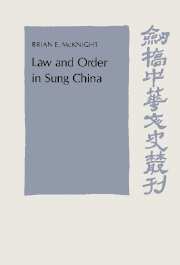Book contents
- Frontmatter
- Contents
- List of figures, maps, and tables
- Preface
- List of abbreviations
- 1 Introduction
- 2 The historical context
- 3 Crimes and criminals
- 4 Informal and semiformal agencies of law enforcement
- 5 Formal civil agencies of law enforcement
- 6 The role of the military in law enforcement
- 7 Supervision of law enforcement – the role of the intendants
- 8 Personnel selection
- 9 Urban crime and urban security
- 10 The Sung penal system
- 11 Jails and jailers in the Sung
- 12 Penal registration
- 13 The death penalty
- 14 Modifications of penalties
- 15 Conclusion
- Glossary
- Bibliography
- Index
4 - Informal and semiformal agencies of law enforcement
Published online by Cambridge University Press: 23 December 2009
- Frontmatter
- Contents
- List of figures, maps, and tables
- Preface
- List of abbreviations
- 1 Introduction
- 2 The historical context
- 3 Crimes and criminals
- 4 Informal and semiformal agencies of law enforcement
- 5 Formal civil agencies of law enforcement
- 6 The role of the military in law enforcement
- 7 Supervision of law enforcement – the role of the intendants
- 8 Personnel selection
- 9 Urban crime and urban security
- 10 The Sung penal system
- 11 Jails and jailers in the Sung
- 12 Penal registration
- 13 The death penalty
- 14 Modifications of penalties
- 15 Conclusion
- Glossary
- Bibliography
- Index
Summary
In the abstract, the problem of law enforcement can be simply stated. Those with a monopoly of legitimate force must receive accurate and timely intelligence of wrongdoing and must be able to mobilize a sufficiently large force of adequately armed, trained, and properly motivated men and to move them to the affected area in a timely fashion, at a cost acceptable to the state. The problem lies in the practice. For economic and ideological reasons, the level of applicable force is usually inversely related to its closeness to the triggering events and to information about those events. Most crimes occur at some remove from the major centers of state force, which are the most highly trained government military units. Those most likely to have accurate information are victims, witnesses, and neighbors. They could react most immediately to the commission of the crime and inform higher authorities. But would they? Even today, with the speed (and anonymity) of electronic communication, a great many crimes are not reported or are not reported immediately. If the authorities come to depend on self-defense by parts of the society outside the formal government apparatus, how can they ensure that these outside agencies will not become too powerful? For premodern Chinese states this was always a dilemma to be lived with, not eliminated.
Self-defense
In the past as in modern times, the first line of social defense was the people themselves. In modern China as in the Sung period, walls go up as wealth goes up.
- Type
- Chapter
- Information
- Law and Order in Sung China , pp. 117 - 146Publisher: Cambridge University PressPrint publication year: 1992

